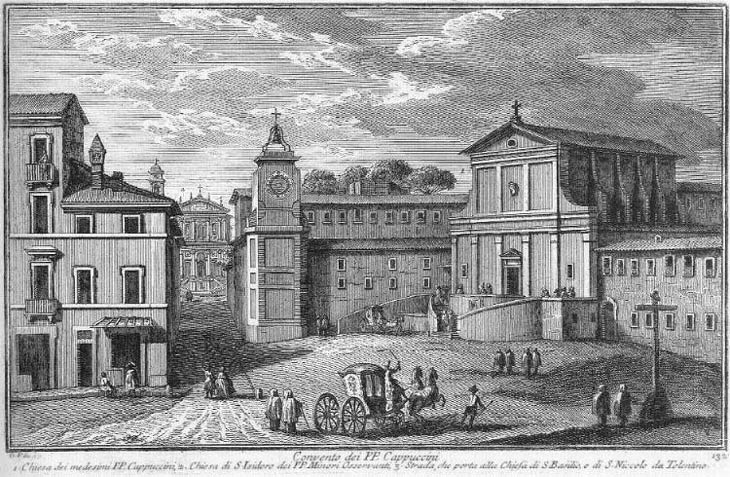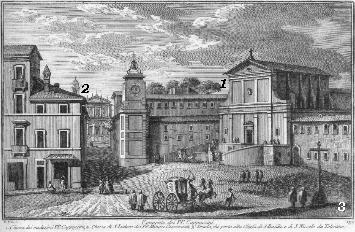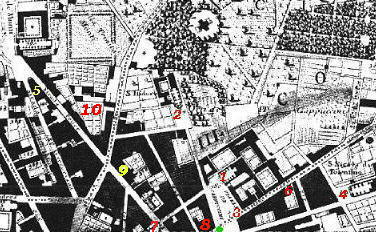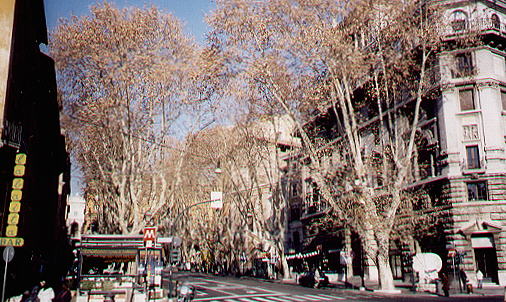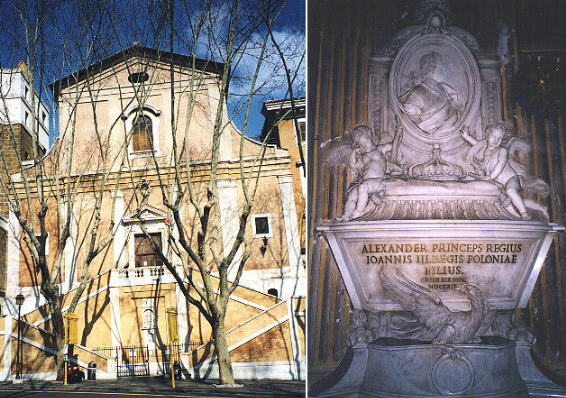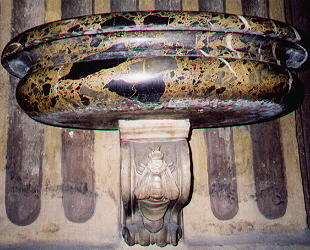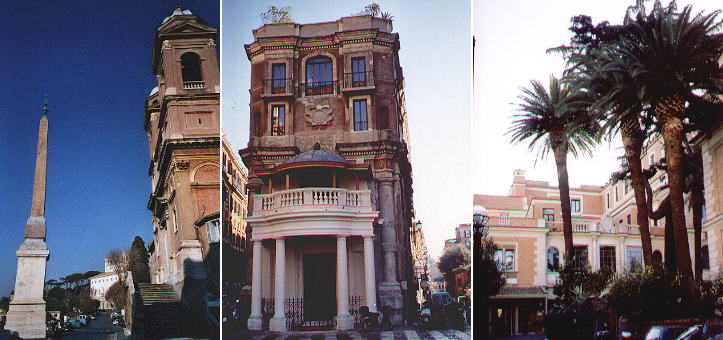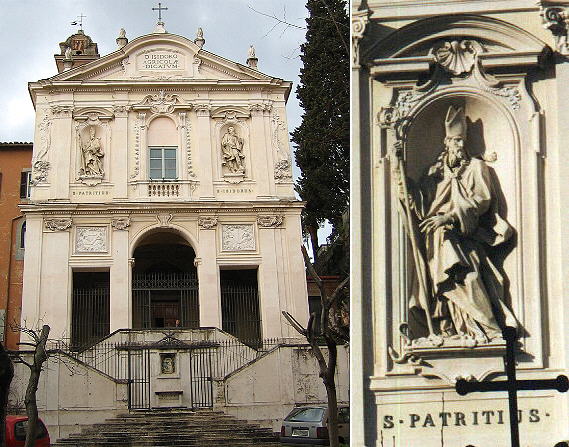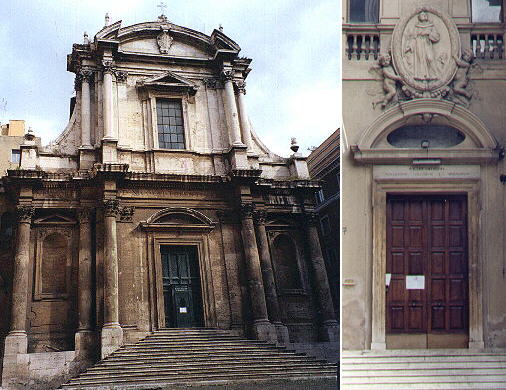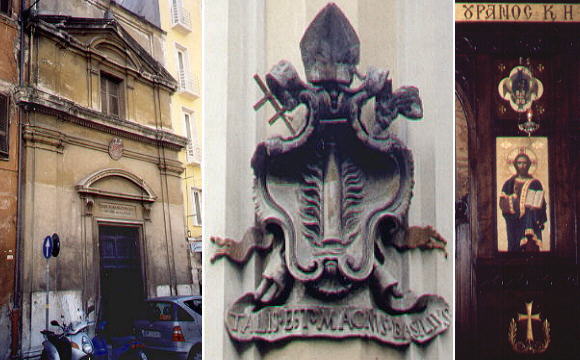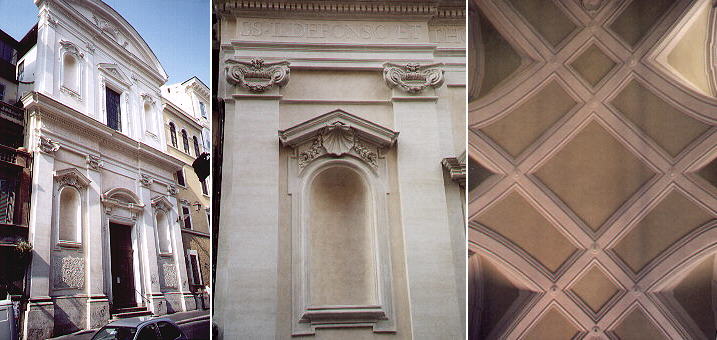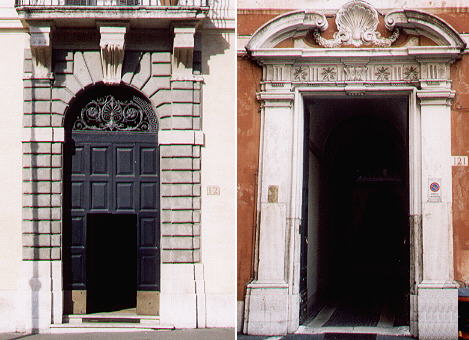

Convento dei Padri Cappuccini
(Book
7) (Map
B2) (Day 2)
(Rione Colonna), (Rione Campo Marzio) and (Rione Trevi)
In this page:
The plate by Giuseppe Vasi
Today's view
The Church of the
Cappuccini
Palazzo della Regina
di Polonia (Palazzo Zuccari) and Villa delle Rose
S. Isidoro
S. Niccolò da Tolentino
S. Basilio
SS. Ildefonso e Tommaso da Villanova
Palazzi Ferri Orsini e Perucchi
The Plate (No. 132)
The Capuchins (hence "cappuccino" the well known Italian white coffee)
used to build their monasteries at the very end of the town, possibly on
elevated ground. In the XVIIIth century Piazza
Barberini (from where this view was taken) was the limit of the populated
area, behind it Villa Ludovisi - Boncompagni
and the Walls of Rome. The view is taken from the green dot in the 1748 map below.
In the description below the plate Vasi made reference to: 1) Chiesa dei PP. Cappuccini; 2) S. Isidoro;
3) Street leading to the churches of S. Basilio and S. Nicola da Tolentino.
The map shows also 4) S. Nicola da Tolentino; 5) Palazzo della Regina di Polonia; 6) S. Basilio;
7) SS. Ildefonso e Tommaso da Villanova; 8) Palazzo Ferri Orsini; 9) Palazzo Perucchi; 10) Villa delle Rose.
The dotted line in the small map delineates
the borders between Rione Campo Marzio (top left quarter), Rione Colonna (in the middle) and Rione Trevi (lower right quarter).
Today
The view today has a Parisian flavour: we are at the start of Via Veneto
a sort of boulevard with cafés, hotels and underground stations.
The Capuchins are still there although their monastery is almost totally
lost. On the right you see the Fountain of the Bees which was moved here
from Via Due Macelli.
The Church
of the
Cappuccini
The church was built at the expense of Cardinal Antonio Barberini
in 1624 at the height of the Baroque century, but the Franciscan ideals
of simplicity prevailed (only a little bee on the holy-water basins reminds us of the patron). The Capuchins are buried inside in five subterranean
chapels decorated with their own bones (read Mark Twain's account of his 1867 visit to these chapels
or read William Dean Howells' account of his 1908 visit). In the church, to the left of the
altar, a baroque tomb by Camillo Rusconi reminds us of the Polish Prince Alexander Sobiesky,
the son of King John III. He lived with the widow of the king, the
Queen Maria Casimira in Palazzo Zuccari, which for this reason was known
as....
Palazzo
della Regina di
Polonia (Palazzo Zuccari)
The little loggia (maybe designed by Juvarra)
was added by the queen to have a better view over SS. Trinità dei Monti
and Villa Medici. The Spanish Steps
(1725) and the obelisk (erected here in 1789) were yet to come and the
area was rather isolated.
The queen rented a small casino on the opposite side
of Via Sistina. The casino was named after its rose-garden Villa delle Rose. Villa delle Rose
is well known to the Germans because Goethe visited it several times and because it was owned by the King of Bavaria.
In 1878 it was bought by the Russian prince Bobrinski who almost entirely rebuilt the old casino (image on the right).
The side of Palazzo Zuccari on Via Gregoriana has very
interesting windows. Further down in Via Gregoriana an inscription marks the house
where Ferdinand Gregorovius lived for many years.
Mariano, the son of Giuseppe Vasi, ignored this palace in his version
of the guide of Rome, but mentioned the Palace of
the Prince of Poland (in this case a Poniatowsky).
S. Isidoro
S. Isidoro was built at the same time as the Church of the Capuchins
by Luke Wadding, the Irish Franciscan who instigated the Irish rebellion
of 1641 (but the façade was designed by Carlo Francesco Bizzaccheri in 1701). On the façade the statues of
S. Isidoro and of St. Patrick (click here for a list of national churches in Rome).
S.
Niccolò da Tolentino
The plate mentions the street leading to the church of S. Niccolò
da Tolentino, which was completed at the expense of the Pamphilj (see their
dove).
Inside the church there is a very fine Pamphilj coat
of arms by Alessandro Algardi. Next to the church there is the entrance to a convent, now used by the Armenian church.
S.
Basilio
The church was part of a small monastery and it was built in 1682. The monastery retains a sort of coat of arms of the saint,
who lived in the IVth century and was considered the father of the Greek church, thus he was called Magnus (the Great). The column surrounded by flames is a symbol of unscathed faith.
The inscription Talis est Magnus Basilius means that the saint's faith resisted all temptations. The church has the iconostasis required by the Greek rite.
SS.
Ildefonso e Tommaso da
Villanova
The church is dedicated to two Spanish saints and it was built by a congregation of Spanish monks in the second half of the XVIIth century. The façade was designed in 1725 by Francesco Ferrari. The
decoration shows a skilled uso of stucco and the ceiling is very similar to that designed by Francesco Borromini in Cappella dei Re Magi.
The church was deconsecrated for a short period during the annexation of Rome to the French Empire at the beginning of the XIXth century.
Palazzi
Ferri Orsini e Perucchi
Because the area near Chiesa dei Cappuccini was considered a remote location, some families
chose it for economical reasons and built small palaces, which in the late XIXth century were largely
modified. However Palazzo Ferri Orsini (late XVIth century) (left) and Palazzo Perucchi (late XVIIth century) (right)
have retained their original portals.
Excerpts from Giuseppe Vasi 1761 Itinerary related to this page:
Chiesa e Convento de' Padri Cappuccini
Dal Card. s. Onofrio cappuccino , e fratello di Urbano VIII. fu eretto questo convento e
chiesa con disegno di Felice Cafoni . Nella prima cappella a destra evvi il celebre
quadro di s. Michele Arcangelo opera di Guido Reni ; nella seconda il s. Francesco del
Muziano, nella terza la Trasfigurazione di Mario Balaffi , nella quarta 1' Orazione all'
Orto di Baccio Ciarpi , ed il s. Antonio nell' ultima di Andrea Sacchi . Nell'altare
maggiore evvi la ss. Concezione dipinta dal Cav. Lanfranco, e sotto l' altare si custodisce
il corpo del dottissimo filosofo s. Giustino martire . A lato del medesimo cappellone si
vede un quadro con s. Francesco dipinto dal Domenichino ; nella prima cappella
dall' altra parte evvi la ss. Vergine con un santo Vescovo del suddetto Andrea Sacchi ;
la natività del Signore nell altra è del Lanfrancho suddetto ; siegue il Cristo morto ,
del Camassei ; poi il s. Felice , di Alessandro Veronese , e nell' ultima la
Conversione di s.Paolo, di Pietro da Cortona . Sopra la porta si vede in cartone
la copia della celebre navicella di s. Pietro dipinta dal Giotto già messa
in mosaico nel portico della basilica Vaticana . Quindi voltando a sinistra del
convento , si vede a destra la chiesa di san Basilio
coll'ospizio de' Monaci, e poco dopo entrando in un vicoletto, evvi la
Chiesa e Convento di S. Niccolò da Tolentino
Fu questa edificata dal Principe Panfili l'anno 1614. con disegno di Gio: Batista Baratta
allievo dell'Algardi, ed è ornata di marmi, stucchi dorati, pitture, e bassirilievi.
La santissima Nunziata nella prima cappella a destra è del Pughelli, e i laterali di Gio:
Ventura Borghesi; le pitture nella terza sono di Pietro Paolo Baldini. Il s. Gio: Batista
nell'altare della crociata è del Baciccio, e li stucchi sono di Ercole Ferrata, il quale
fece marmo il Dio Padre, ed il s. Niccolò nell'altare maggiore; la ss. Vergine però fu
fatta da Domenico Guidi, e gli Angioli sono del Baratta, il tutto col disegno dell'Algardi.
La cupola fu dipinta dal Coli unitamente col Giraldi amendue Lucchesi, e li angoli dal
Baldini, il quale dipinse ancora tutta la cappelletta della parte destra. La s. Agnese
nella crociata è copia del Guercino, e li stucchi sono del Ferrata. La nobilitata cappella,
che siegue, è magnifico disegno di Pietro da Cortona, il quale dipinse la piccola volta, che
fu l’ultima sua opera a fresco, è perchè neppure potè compirla, la terminò Ciro Ferri suo
allievo. Il bassorilievo nell'altare è di Cosimo Fancelli, la statua di s. Gio. Batista del
Raggi, e quella di san Giuseppe di Ercole Ferrata, e i bassirilievi sotto l'organo sono del
Baratta. Nel convento vi sono i frati riformati di s. Agostino.
Chiesa di S. Isidoro
Circa l'anno 1622. fu eretta questa chiesa da' frati riformati di s. Francesco di
nazione Spagnola, col disegno di Carlo Bizzoccheri: ma dipoi vi fu stabilito un
collegio di frati Osservanti di nazione Ibernese. Nella chiesa sonovi de' quadri di
molta considerazione; lo Sposalizio della ss. Vergine co' laterali nella prima cappella
a destra sono prime opere di Carlo Maratti; le pitture nella seconda sono di Pietro
Paolo Baldini, la ss. Concezione col Bambino nella cappelletta è bellissima opera del
mentovato Carlo Maratta, e le sculture sono del figlio del Cav. Bernino.
Il s. Isidoro nell'altare maggiore è di Andrea Sacchi; il s. Agostino, e s. Francesco
nella cappelletta laterale sono di uno Spagnolo; il s. Antonio di Padova con i laterali
di Gio: Domenico Perugino, le lunette però sono di Egidio Alè Liegese; ed il
ss. Crocifisso con i laterali nell'ultima cappella sono del lodato Carlo Maratta.
Or facendo ritorno alla strada felice, si vede a sinistra la
Chiesa di S. Ildefonso
Da' frati Eremitani Spagnoli fu edificata questa l'anno 1619. e dipoi riedificata con
disegno di Luigi Paglia Siciliano, nella quale evvi la natività del Signore scolpita in
bassorilievo da Francesco cognomiato il Siciliano. Poco dopo a destra è la piccola chiesa di
S. Francesca Romana rinnovata l’anno 1614. da frati Trinitarj Spagnoli, nella quale
fra gli altri quadri evvi la ss. Vergine con gli Angioli del ricatto dipinta da
Francesco Cozza.
Palazzo abitato dalla Regina di Polonia
Nel fine della strada Felice si vede a sinistra questo palazzo, eretto da' celebri pittori
Taddeo, e Federigo Zuccheri per loro abitazione, nel quale fecero delle belle
pitture a fresco; e vi abitò Maria Casimira Regina di Pollonia.
|
Next plate in Book 7: Chiesa di S. Marcello
Next step in Day 2 itinerary: Porta Salara
Next step in your tour of Rione Colonna:
Villa e Casino Ludovisi
Next step in your tour of Rione Campo Marzio: Palazzetto dei Borgognoni
Next step in your tour of Rione Trevi: Palazzo Galloppi

Go
to  or to Book
7 or to my Home
Page on Baroque Rome or to my Home Page on Rome
in the footsteps of an XVIIIth century traveller.
or to Book
7 or to my Home
Page on Baroque Rome or to my Home Page on Rome
in the footsteps of an XVIIIth century traveller.
All images © 1999 - 2002 by Roberto Piperno. Write to romapip@quipo.it
|


